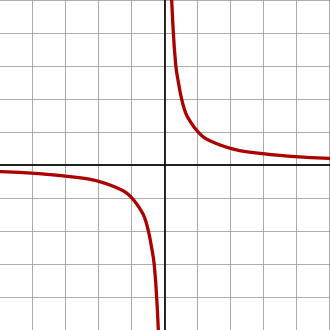Gabriel's Horn

Gabriel's horn (also called Torricelli's trumpet) is a geometric figure which has infinite surface area but finite volume. The name refers to the tradition identifying the Archangel Gabriel as the angel who blows the horn to announce Judgment Day, associating the divine, or infinite, with the finite. The properties of this figure were first studied by Italian physicist and mathematician Evangelista Torricelli in the 17th century.
Mathematical definition

Gabriel's horn is formed by taking the graph of
with the domain x > 1 (thus avoiding the asymptote at x = 0) and rotating it in three dimensions about the x-axis. The discovery was made using Cavalieri's principle before the invention of calculus, but today calculus can be used to calculate the volume and surface area of the horn between x = 1 and x = a, where a > 1. Using integration (see Solid of revolution and Surface of revolution for details), it is possible to find the volume V and the surface area A:
a can be as large as required, but it can be seen from the equation that the volume of the part of the horn between x = 1 and x = a will never exceed π; however, it will get closer and closer to π as a becomes larger. Mathematically, the volume approaches π as a approaches infinity. Using the limit notation of calculus:
The surface area formula above gives a lower bound for the area as 2π times the natural logarithm of a. There is no upper bound for the natural logarithm of a as a approaches infinity. That means, in this case, that the horn has an infinite surface area. That is to say;
Apparent paradox
When the properties of Gabriel's horn were discovered, the fact that the rotation of an infinitely large section of the xy-plane about the x-axis generates an object of finite volume was considered paradoxical.
Actually, while the section lying in the xy-plane has an infinite area, any other section parallel to it has a finite area. Thus the volume, being calculated from the 'weighted sum' of sections, is finite.
A perhaps more convincing approach is to treat the horn as a stack of disks with diminishing radii. As their shape is identical, one is tempted to calculate just the sum of radii, which produces the harmonic series that goes to infinity. A more careful consideration shows that one should calculate the sum of their squares. Every disk has a radius r = 1/x and an area πr2 or π/x2. The series 1/x diverges but 1/x2 converges. In general, for any real ε > 0, 1/x1+ε converges.
The apparent paradox formed part of a dispute over the nature of infinity involving many of the key thinkers of the time including Thomas Hobbes, John Wallis and Galileo Galilei.[1]
Painter's paradox
Since the horn has finite volume but infinite surface area, it seems that it could be filled with a finite quantity of paint, and yet that paint would not be sufficient to coat its inner surface – an apparent paradox. In fact, in a theoretical mathematical sense, a finite amount of paint can coat an infinite area, provided the thickness of the coat becomes vanishingly small "quickly enough" to compensate for the ever-expanding area, which in this case is forced to happen to an inner-surface coat as the horn narrows. However, to coat the outer surface of the horn with a constant thickness of paint, no matter how thin, would require an infinite amount of paint.[2]
Of course, in reality, paint is not infinitely divisible, and at some point the horn would become too narrow for even one molecule to pass. But the horn too is made up of molecules and so its surface is not a continuous smooth curve, and so the whole argument falls away when we bring the horn into the realm of physical space, which is made up of discrete particles and distances. We talk therefore of an ideal paint in a world where limits do smoothly tend to zero well below atomic and quantum sizes: the world of the continuous space of mathematics.
Converse
The converse phenomenon of Gabriel's horn – a surface of revolution that has a finite surface area but an infinite volume – cannot occur:
Theorem
Let f : [1,∞) → [0,∞) be a continuously differentiable function. Write S for the solid of revolution of the graph y = f(x) about the x-axis. If the surface area of S is finite, then so is the volume.
Proof
Since the lateral surface area A is finite, note the limit superior:
Therefore, there exists a t0 such that the supremum sup{ f(x) | x ≥ t0} is finite. Hence,
- M = sup{ f(x) | x ≥ 1} must be finite since f is a continuous function, which implies that f is bounded on the interval [1,∞).
Finally, note that the volume:
Therefore: if the area A is finite, then the volume V must also be finite.
See also
References
Further reading
- Gabriel's Other Possessions, Melvin Royer, doi:10.1080/10511970.2010.517601
- Gabriel's Wedding Cake, Julian F. Fleron
- A Paradoxical Paint Pail, Mark Lynch
- Supersolids: Solids Having Finite Volume and Infinite Surfaces, William P. Love, JSTOR 27966098
External links
- Information and diagrams about Gabriel's horn
- Torricelli's trumpet at PlanetMath
- Weisstein, Eric W. "Gabriel's Horn". MathWorld.
- "Gabriel's Horn" by John Snyder, the Wolfram Demonstrations Project, 2007.
- Gabriel's Horn: An Understanding of a Solid with Finite Volume and Infinite Surface Area by Jean S. Joseph.